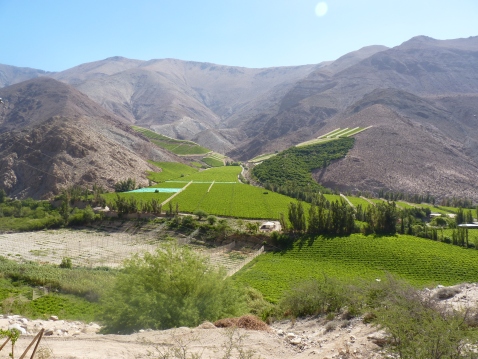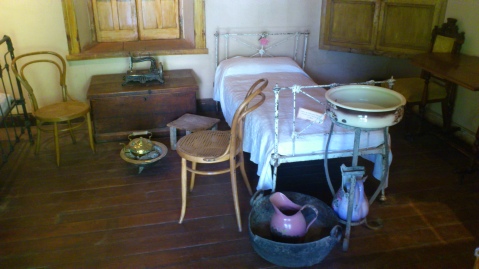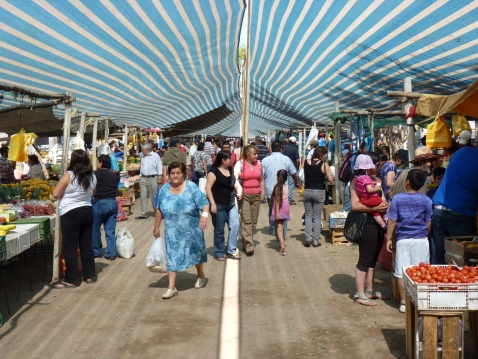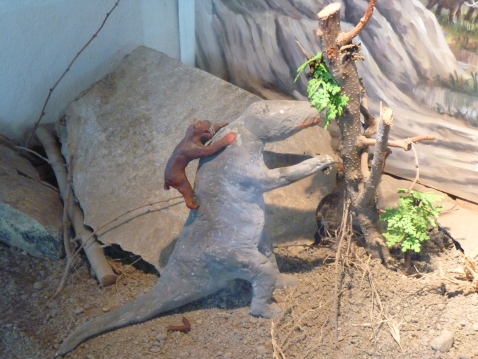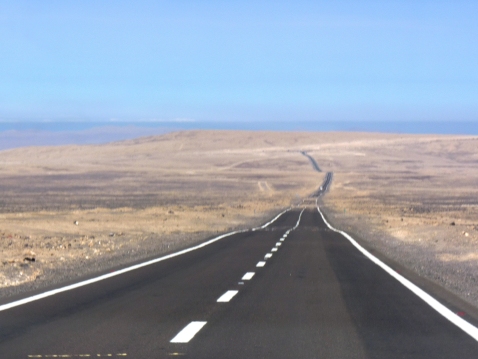El Grande Norte 2: Elqui to the Atacama
I can see why the hippies liked the Elqui Valley. An oasis in the desert fed by the Elqui river, this lush valley is surrounded by arid mountain tops silhouetted by famously crystal clear skies. There is definitely an ‘onda’, or vibe to the place. It’s zen. According to the alternative lifestyle seekers who flocked here in the 1960s, it’s actually the centre of the Earth’s magnetism, which shifted from the South Pole to roughly this spot in Chile. While I did feel drawn down the valley, I think this was more because of the aesthetics of the place, rather than its magnetic field. With Gerald at the wheel of our white Nissan Tiida, and his four passengers in tow, we headed upstream to see what all the fuss was about.
The contrast between green vineyards and the rocks beyond is the first thing that hits you, and it is stunning. You can see how the place must have inspired the Chilean poet Gabriella Mistral, who was born here in 1889 in the town of Vicuña, at the opening of the valley, but grew up further upstream in the small village of Montegrande. There is a small museum and statue in this tiny village dedicated to poet, educator and feminist who is still the only Latin American women to have won the Nobel Prize for literature. You get a chance to peer into the original bedroom of the young Gabriella (born Lucila Godoy Alcayaga), read original letters and samples of poetry. Sadly my Castellano is not of a high enough standard to appreciate the literature, so a return visit might be necessary. A few signs of the alternative folk who made a life here is still evident, like the dreadlocked couples selling Mapuche symbols carved from gourd skin. Generally they must be tucked away further up the valley. Most of the people we encountered were tourists, Chilean and Gringo, more interested in Mistral than magnetism.
Heading back out of the valley you reach Vicuña (not to be mistaken for one of these guys), a more lively town with a busy market and large Plaza de Armas (try and find a town in Chile without one). If you have time you can arrange a visit to an observatory for a few thousand pesos, with transport provided and see the stunning night sky through a scope. With little time we had to remain Earth bound, visiting instead a fascinating, albeit dusty entomology and natural history museum on the south side of the plaza. This had an impressive collection of semi-precious stones and seashells from around the world and some inspiring displays:
As you travel north away from the Elqui Valley you start to enter the Atacama proper. This is where the north of Chile starts getting weird. The Pan-American highway, the artery through which almost all of Chile’s goods, people, food and beer flow, runs like a line of hot treacle across this arid expanse. The scale alone impresses. Tiny specs in the distance take 15 minutes to reach you, becoming vast trucks loaded with anything from sulphuric acid for the copper mines, to beer, for…well, probably the copper mines… and everyone else who lives in this barren place. Beer does seem to be the lifeblood of this part of Chile. Almost every other truck is a Crystal truck.
Yes, the Crystal highway ensures that even on the driest place on earth, beer is within easy reach. Having spent two weeks in this place, you can understand the urge to drink. It’s barren. Sure, the landscapes are stunning. Beginning with undulating red and golden hills you slowly creep upwards and northwards onto vast flat plains with the white foothills of the Andes shimmering in the distance. But there is nothing here. A rock stands out as a point of interest. Something to go and look at! The road itself is the most interesting thing to marvel at. The way it crawls on, unforgiving, through plain, mountain and valley with nothing to support it but itself. How they ever built this thing out here is beyond comprehension.
A few hundred miles north of La Serena the road takes a rare turn and heads for the coast. Just as you become accustomed to the bareness of the desert, as the road winds down valleys towards the pacific you are hit with a dose of something unexpected. Bleakness. Yellow sun, white desert and golden hills I can handle. Grey skies, grey rock, grey sea, I cannot. The coast from here to Iquique is blanketed by an almost permanent layer of thick, low cloud, washing out the colour palate of the desert and creating a land of monotone. It was here, during a night in the small town of Taltal, that food poising took us by surprise and the journey north seemed its bleakest yet…
10 things you probably don’t need to know about Chile
Here are ten observations about Chile for the uninitiated:
1) Chileans like to eat. A lot. Even their drinks have food in.
They get lunch and dinner the wrong way round. Lunch is a huge, 3 course meal. Dinner is sandwiches and cake, with tea (they call it ‘onces’, which is derived from the English ‘elevenses’, even though you have it anywhere between 6pm and 10pm. Hmm.)
2) More than anything, Chileans like to eat pan. That’s bread to you and me. This is not unusual in Chile:
Oh, and avocados. Just don’t say to a Chilean, “Me gusta comer avocados”. They’ll think that you like to eat lawyers. Which probably isn’t such a bad thing. Avocados are called paltas. Learn that word, you will hear it a lot.
3) Chileans don’t drink. They make all this amazingly lovely wine and vast quantities of lager, which they sell for peanuts, and then they don’t drink it. I’ve been to parties, BBQ’s and even pubs and most of the adults there are drinking bebidas (soft drinks!). Ok, ok, so they might have a small glass of wine, or half a can of beer with a meal. But they don’t drink, not like the English. This is a tough one to adjust to. I drank a can of beer in the park one day* and people looked at me like I was a crazed alcoholic. Maybe I should have put some clothes on.
4) Chilean people are really lovely**. Families are closer and people are more affectionate here. Touching is good, and encouraged. Especially on the metro where it is unavoidable. You can’t walk through a park without seeing dozens of couples, of various ages, kissing.
5) Dogs are EVERYWHERE in Chile. Dogs that are owned by someone tend to be small and white:
Dog’s that aren’t owned by someone tend to be brown and kind of creepy:
6) Chileans do everything slowly, calmly, and without sign of anger or frustration. Except driving. Put a Chilean behind a steering wheel and they are transformed into an ADHD racing driver with a redbull habit. In England I never, ever, saw a car accident actually happen before my eyes. In 3 months here I have seen four.
7) It’s impossible to get lost in Chile, even without Google Maps. Andes on the right when facing north. Andes on the left when facing south. If you’re hot, walk south to Santiago. If you’re cold, walk north to Santiago.
8) Chile was founded by an Irishman (well, half Irish) named Bernard. He had ginger whiskers and everything.
9) The television is truly awful. There are roughly 10 Chilean TV celebrities who take it in turns to sit on sofas to talk about the other 8 or 9 Chilean celebrities. Thankfully people here spend more time eating and talking with their families than watching TV, so this isn’t as much of a problem as it would be in England.
10) Don’t expect to be able to understand anyone here for at least 6 months. Even if you speak Spanish. Chileans don’t speak Spanish, they speak Chilean.
*Ah, apparently its illegal.
**Except for punks. Punks don’t seem to like extranjeros (foreigners), which is why they spit at you.
Next post I’ll update on the mission to El Grande Norte, which included, among other things: meteor craters, the world’s biggest copper mine (its BIG), valle de la luna, endless lifeless expanses of desert, driving on three wheels through the Altiplano salt flats and a night on the floor of a remote Argentinean border post. Hasta luego amigos.
